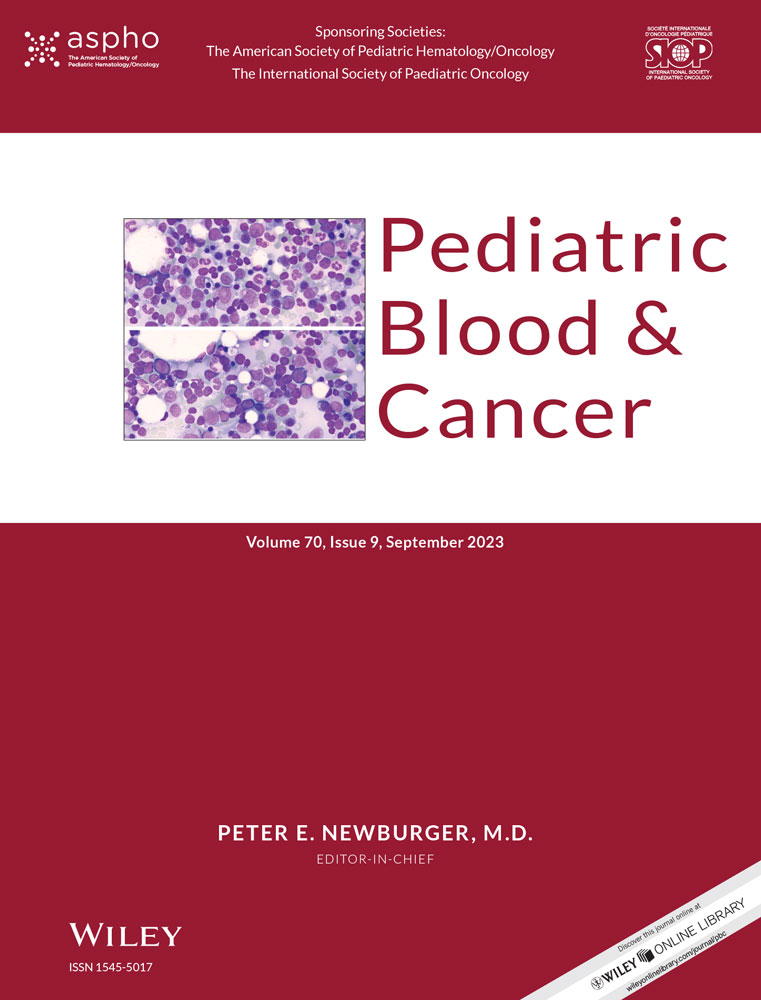Lorlatinib use in an infant with thalamic ALK-positive histiocytosis
Irem Eldem
Division of Pediatric Hematology/Oncology, Department of Pediatrics, Washington University School of Medicine, St Louis, Missouri, USA
Search for more papers by this authorJennifer Picarsic
Division of Pathology, Cincinnati Children's Hospital Medical Center, Cincinnati, Ohio, USA
Search for more papers by this authorAshish Kumar
Division of Bone Marrow Transplant and Immune Deficiency, Cincinnati Children's Hospital Medical Center, Cincinnati, Ohio, USA
University of Cincinnati College of Medicine, Cincinnati, Ohio, USA
Search for more papers by this authorYaël P. Mossé
Division of Oncology and Center for Childhood Cancer Research, Children's Hospital of Philadelphia, Philadelphia, Pennsylvania, USA
Perelman School of Medicine at the University of Pennsylvania, Philadelphia, Pennsylvania, USA
Search for more papers by this authorKaleigh Filisa Roberts
Division of Neuropathology, Department of Pathology & Immunology, Washington University School of Medicine, St Louis, Missouri, USA
Search for more papers by this authorAmy E. Armstrong
Division of Pediatric Hematology/Oncology, Department of Pediatrics, Washington University School of Medicine, St Louis, Missouri, USA
Search for more papers by this authorCorresponding Author
Bryan A. Sisk
Division of Pediatric Hematology/Oncology, Department of Pediatrics, Washington University School of Medicine, St Louis, Missouri, USA
Bioethics Research Center, Department of Medicine, Washington University School of Medicine, St Louis, Missouri, USA
Correspondence
Bryan A. Sisk, Department of Pediatrics, Division of Hematology/Oncology, Washington University School of Medicine, 4523 Clayton Ave, Campus Box 8005, St Louis, MO 63110, USA.
Email: [email protected]
Search for more papers by this authorIrem Eldem
Division of Pediatric Hematology/Oncology, Department of Pediatrics, Washington University School of Medicine, St Louis, Missouri, USA
Search for more papers by this authorJennifer Picarsic
Division of Pathology, Cincinnati Children's Hospital Medical Center, Cincinnati, Ohio, USA
Search for more papers by this authorAshish Kumar
Division of Bone Marrow Transplant and Immune Deficiency, Cincinnati Children's Hospital Medical Center, Cincinnati, Ohio, USA
University of Cincinnati College of Medicine, Cincinnati, Ohio, USA
Search for more papers by this authorYaël P. Mossé
Division of Oncology and Center for Childhood Cancer Research, Children's Hospital of Philadelphia, Philadelphia, Pennsylvania, USA
Perelman School of Medicine at the University of Pennsylvania, Philadelphia, Pennsylvania, USA
Search for more papers by this authorKaleigh Filisa Roberts
Division of Neuropathology, Department of Pathology & Immunology, Washington University School of Medicine, St Louis, Missouri, USA
Search for more papers by this authorAmy E. Armstrong
Division of Pediatric Hematology/Oncology, Department of Pediatrics, Washington University School of Medicine, St Louis, Missouri, USA
Search for more papers by this authorCorresponding Author
Bryan A. Sisk
Division of Pediatric Hematology/Oncology, Department of Pediatrics, Washington University School of Medicine, St Louis, Missouri, USA
Bioethics Research Center, Department of Medicine, Washington University School of Medicine, St Louis, Missouri, USA
Correspondence
Bryan A. Sisk, Department of Pediatrics, Division of Hematology/Oncology, Washington University School of Medicine, 4523 Clayton Ave, Campus Box 8005, St Louis, MO 63110, USA.
Email: [email protected]
Search for more papers by this authorOpen Research
DATA AVAILABILITY STATEMENT
The data that support the findings of this study are available on request from the corresponding author.
REFERENCES
- 1Emile JF, Cohen-Aubart F, Collin M, et al. Histiocytosis. Lancet. 2021; 398(10295): 157-170.
- 2Khoury JD, Solary E, Abla O, et al. The 5th edition of the world health organization classification of haematolymphoid tumours: myeloid and histiocytic/dendritic neoplasms. Leukemia. 2022; 36(7): 1703-1719.
- 3Wen PY, Macdonald DR, Reardon DA, et al. Updated response assessment criteria for high-grade gliomas: response assessment in neuro-oncology working group. J Clin Oncol. 2010; 28(11): 1963-1972.
- 4Kemps PG, Picarsic J, Durham BH, et al. ALK-positive histiocytosis: a new clinicopathologic spectrum highlighting neurologic involvement and responses to ALK inhibition. Blood. 2022; 139(2): 256-280.
- 5He Q, Zhang W, Li Q. Failure of crizotinib based systemic treatment in ALK positive histiocytosis involving the central nervous system: a case report and literature review. BMC Pediatr. 2022; 22(1): 308.
- 6Tian Y, Li J, Liu B, Xie H, Zheng M, Yao W. ALK-positive histiocytosis with disseminated disease responded to alectinib: a case report. Ann Palliat Med. 2021; 10(9): 10095-10101.
- 7Bresler SC, Weiser DA, Huwe PJ, et al. ALK mutations confer differential oncogenic activation and sensitivity to ALK inhibition therapy in neuroblastoma. Cancer Cell. 2014; 26(5): 682-694.
- 8Goldsmith KC, Kayser K, Groshen SG, et al. Phase I trial of lorlatinib in patients with ALK-driven refractory or relapsed neuroblastoma: a new approaches to neuroblastoma consortium study. J Clin Oncol. 2020; 38(15):10504.
- 9Bauer TM, Felip E, Solomon BJ, et al. Clinical management of adverse events associated with lorlatinib. Oncologist. 2019; 24(8): 1103-1110.




